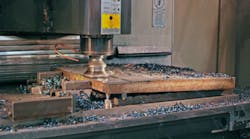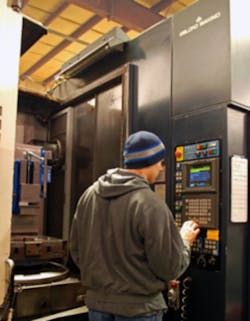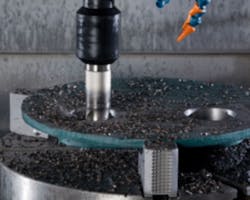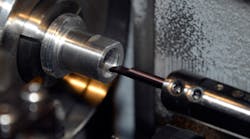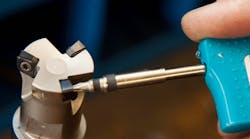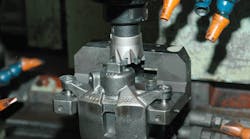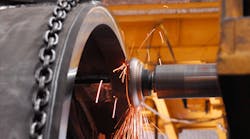Diversifying into contract machining can be a lifesaver for a branded capital equipment manufacturer, as long as it stays both profitable and competitive. At the operational end, this may require advanced machining practices and equipment – and confidence in those practices — and an appetite to try new things. Wemco Inc. in Airway Heights, Wash., is a handy example.
Wemco learned these lessons in contract machining early and well, about five years ago, and today it continues to gain the benefits of the switch. In 2008, 90% of the business involved made-to-order heavy equipment, very cyclical and vulnerable to economic turndowns. Today the business is 40-60 % contract milling, which is steadier work, more profitable and more amenable to scheduling. It keeps 28 shop workers busy, 10/5, in a 36,000-sq. ft. machining and fabrication shop.
“At the manufacturing end, our key to success has been to embrace leading-edge machining practices, mostly high-feed milling, and to keep pushing it,” according to Juston Rouse, manufacturing vice president. “We’ve reduced our plant-wide milling costs by half as a result, and can deliver a contract job within three weeks on average. We can win a lot of jobs with that capability — and still hold good margins.”
In this effort most of the tooling Wemco has selected is from the Ingersoll Hi-Feed series, which feeds faster but takes lighter cuts that lead to higher material removal rates (MRR) with less wear and tear on the machines. The typical parameters for mild steel are 240 IPM at 0.050 in. DOC, versus 80 IPM at 0.070-0.120 in.
“The math is clear,” Rouse said. “Tripling the feed while reducing DOC by maybe half means we’re doubling the MRR, at least.”
Wemco’s bottom line looks good today, but it didn’t happen overnight, nor without serious doubts. The company started contract machining about seven years ago, after converting the shop to modern CNC operation but with conventional tooling. That move created a lot of free machine time to sell, but because of local competition Wemco got the work and couldn’t make any profit on it.
About a year and a half later, Rouse sought ideas from a range of tooling suppliers to lower the shop’s machining costs. Ingersoll’s Chris Murray immediately recommended high-feed practices and promised at least a 50% improvement in machining rates.
“I won’t repeat my exact reply at the time,” said Rouse, “but, long story short, we tested the idea and the result was a 3-to-1 gain in MRR.” He immediately bought $87,000 worth of Ingersoll high-feed tooling and scrapped what they had. “We didn’t have time to inch into the new practices,” he added.
High-Feed Geometry, Close Up
Murray explained that the geometry of a high-feed insert is quite different from standard inserts. “Typically they feature large sweeping radii, shallow backdrafts, and positive rakes,” he said. These geometries make for an extremely strong insert that reduces cutting forces and directs them inward and up machine spindles, thereby minimizing lateral cutting forces and vibration. The chips come off in a lot of small curlicues rather than a few big “sixes and nines.”
The reduced cutting forces in high-feed milling often stem from trochoidal toolpaths, or a programming practice called “peel milling.” The toolpath, not the tool itself, generates the cut geometry. The “peel milling” approach promotes the higher MRRs without raising cutting forces.
Wemco’s trial also showed that in corners the smaller, faster-feeding cutters can rough nearer to net shape than a husky, big-radius corncob cutter. As the Ingersoll cutter moved through corners, there was no spike in spindle load.
The next challenge for Rouse was to make believers out of his very skeptical programmers and machine operators. Accordingly, Chris Murray spent a lot of time machine-side, showing them how to make the leap and getting them to trust the recommended parameters.
“All our long-timers are now converts, but it still takes some convincing with the new hires,” said Rouse. “On the one hand it takes time to create that mentality shift; on the other it reassures us that we have a real competitive edge. After all, if the new hires haven’t seen rates like this where they worked before, we must be doing something right.”
Naturally, Wemco introduced high-feed milling on the safe jobs at first: routine roughing, finishing, and slotting in mild steel. Usually the gain was about 3 to 1 in MRR, and 2 to 1 in insert life.
Then, with Chris Murray’s advice each time, Rouse extended the practice to more challenging jobs, such as hard-part and long-reach milling, and unconventional applications like corkscrew milling of large holes
“We’re making money on jobs we wouldn’t have bid on without Chris’s input” he said.
Some of the typical recent jobs have included:
• Milling an 18-inch deep slot in mild steel on a light-frame CNC machine. Such extreme, long-reach work would not be possible with a conventional corncob roughing cutter because of the chatter and lateral cutting forces it would generate. The tooling package is a 2-inch Ingersoll Form-Master Plus high-feed mill on an advanced all-carbide Inno-Fit extension shank. The parameters are 525 SFM, 300 IPM, 0.050 in. DOC.
• Debottlenecking a long-cycle milling job that kept the machine running 22 hours per day, and turned the cutter red-hot so it cooked the inserts. At only 25 IPM, conventional tools needed insert replacement 2-3 times a day. Now, with a 1-in. Ingersoll Powerfeed Plus high-feed tool, the job runs at 170 IPM and tools last twice as long. We call it ‘the everlasting gob stopper’,” Rouse quipped.
• Corkscrew milling for large flame-cut holes. A “one size fits all” Ingersoll high-feed mill, finishes the holes twice as fast as twist drills. “It also makes our lives easier because we need stock fewer drill sizes,” said Rouse. Occasionally, Wemco also has produced 2-in. holes in 0.25-in. stock simply by plunge milling with a 2-ft. Ingersoll Proball high-feed ball mill. The technique reduces a 1-minute drilling job to 20 seconds — and takes a lot less horsepower.
• Hard-part milling in half the time, with twice the tool life. For example, Wemco completed an eight-hour job in T1 stock (Rc 40-50) in four hours and at half the insert wear rate. It routinely mill parts in Nitronic, Rc 50; AR plate 400, 500, Rc 52+; and a mix of wear iron jobs. “We’ve gained a reputation for taking on hard-part milling jobs that competitors won’t touch,” Rouse said. “Now this specialty represents about 10% of our contract business, and is one of our more profitable niches.”
The tooling for hard-part work, Ingersoll Form Master Pro, is a close cousin to the pure high-feed styles used for mild steel. Typical parameters for the hard part work with the 2-in., 5-insert high-feed cutter are 283 SFM, 20 IPM, 0.076-in. DOC.
Consistently Longer Lasting
Wemco tests other high-feed tools from time to time as a matter of course. A few cut as fast, but the Ingersolls consistently beat them on tool life, according to Rouse.
“It’s a matter of taking the time to job-match every aspect of tool selection,” said Murray, “geometry, grade coating and especially edge prep.”
A couple of organizational changes have improved efficiency too. Some of the most valuable players on the shop floor are called project managers, and they combine operating and programming functions into one functional responsibility in the shop. It has been a step that brings a real-life sensibility to programming. As a matter of standard practice, moreover, these individuals will log-in to the standard MasterCam or Gibbs software specifically to streamline the rapid-traverse toolpaths, which helps to achieve 5-8% savings in “airtime” for every job.
Currently, Rouse and Murray are developing a special drill for a very deep hole plunges — 33:1. It’s for another job Wemco wouldn’t have taken on without input from Murray.
